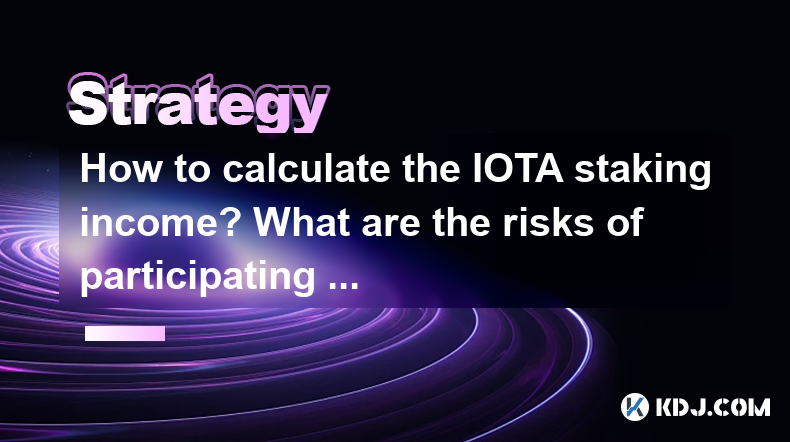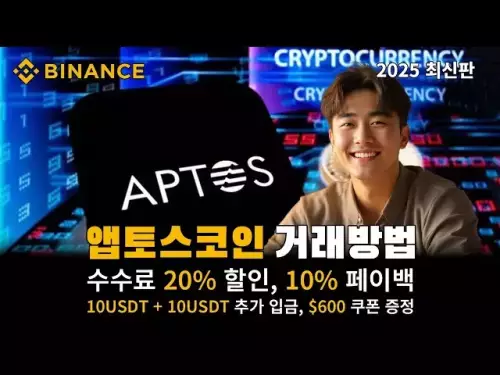-
 bitcoin
bitcoin $112715.707551 USD
-1.71% -
 ethereum
ethereum $4101.475385 USD
-3.01% -
 tether
tether $1.000644 USD
-0.02% -
 bnb
bnb $1207.619465 USD
-6.77% -
 xrp
xrp $2.501451 USD
-3.98% -
 solana
solana $202.947124 USD
-3.32% -
 usd-coin
usd-coin $1.000295 USD
0.04% -
 dogecoin
dogecoin $0.203884 USD
-4.47% -
 tron
tron $0.317154 USD
-1.72% -
 cardano
cardano $0.695009 USD
-4.43% -
 hyperliquid
hyperliquid $38.853961 USD
-8.23% -
 chainlink
chainlink $18.988674 USD
-4.64% -
 ethena-usde
ethena-usde $1.000233 USD
-0.03% -
 stellar
stellar $0.337050 USD
-3.63% -
 bitcoin-cash
bitcoin-cash $536.861728 USD
-1.28%
How to calculate the IOTA staking income? What are the risks of participating in staking?
Calculate IOTA staking income by multiplying your staked amount by the APR; consider compounding for higher returns, but be aware of market volatility and validator risks.
Apr 30, 2025 at 10:01 pm

Introduction to IOTA Staking
IOTA is a distributed ledger technology that enables feeless microtransactions and data integrity for the Internet of Things (IoT). Recently, IOTA introduced staking, allowing users to participate in network validation and earn rewards. Understanding how to calculate your potential income from IOTA staking and the associated risks is crucial for making informed decisions.
How to Calculate IOTA Staking Income
Calculating your potential income from IOTA staking involves understanding the staking rewards structure and the amount of IOTA you are willing to stake. Here’s a detailed breakdown of the process:
Determine Your Staking Amount: The first step is to decide how much IOTA you want to stake. The more IOTA you stake, the higher your potential rewards, but also the higher the risk.
Understand the Staking Rewards: IOTA’s staking rewards are distributed based on the network's performance and the total amount of IOTA staked across the network. Typically, the reward rate is expressed as an Annual Percentage Rate (APR). For example, if the APR is 5%, and you stake 1000 IOTA, your annual reward would be 50 IOTA.
Calculate Your Rewards: To calculate your staking income, you can use the formula: Staking Income = Staked Amount APR. If you stake 1000 IOTA at an APR of 5%, your annual income would be 1000 0.05 = 50 IOTA.
Consider Compounding: If you choose to reinvest your staking rewards, you can benefit from compounding. Compounding can significantly increase your total income over time. To calculate compounded returns, you can use the formula: A = P(1 + r/n)^(nt), where A is the amount of money accumulated after n years, including interest, P is the principal amount (the initial amount you stake), r is the annual interest rate (decimal), n is the number of times that interest is compounded per year, and t is the time the money is invested for in years.
Factors Affecting IOTA Staking Income
Several factors can influence your IOTA staking income:
Network Performance: The performance of the IOTA network can impact the APR. Higher network activity and more transactions can lead to higher rewards.
Total Staked Amount: The total amount of IOTA staked across the network can affect individual rewards. If more IOTA is staked, the rewards might be diluted unless the network's overall rewards increase proportionally.
Validator Performance: As a staker, you might delegate your stake to a validator. The performance of the validator you choose can affect your rewards. Validators with higher uptime and better performance can yield higher rewards.
Risks of Participating in IOTA Staking
While staking can be a lucrative way to earn passive income, it comes with its own set of risks. Here are some key risks to consider:
Market Volatility: The value of IOTA can fluctuate significantly. If the price of IOTA drops after you stake, the value of your rewards in fiat currency could be less than expected.
Validator Risk: If you delegate your stake to a validator, you are reliant on their performance. If the validator underperforms or goes offline, you might not receive the expected rewards, or worse, you could lose part of your stake.
Slashing: In some staking systems, validators can be penalized for malicious behavior or downtime, a process known as slashing. Although IOTA’s current staking model does not include slashing, it is essential to stay informed about any changes to the protocol.
Liquidity Risk: Staking typically requires locking up your IOTA for a certain period. During this time, you cannot sell or use your staked IOTA, which could be problematic if you need liquidity.
How to Start Staking IOTA
If you decide to participate in IOTA staking, here are the steps to get started:
Set Up a Wallet: You need a compatible wallet to stake IOTA. Download and set up a wallet that supports IOTA staking, such as the official IOTA wallet.
Acquire IOTA: Purchase IOTA from a reputable exchange and transfer it to your wallet.
Choose a Validator: Research and select a validator to delegate your stake. Consider their performance, fees, and reputation.
Stake Your IOTA: In your wallet, navigate to the staking section, select your validator, and enter the amount of IOTA you want to stake. Confirm the transaction to start staking.
Monitor Your Stake: Keep an eye on your staking rewards and the performance of your chosen validator. Adjust your staking strategy as needed based on network conditions and validator performance.
Frequently Asked Questions
Q: Can I unstake my IOTA at any time?A: The ability to unstake IOTA depends on the specific staking rules in place. Some staking systems may have a lock-up period during which you cannot unstake your tokens. Always check the current staking terms before participating.
Q: Is there a minimum amount of IOTA required to stake?A: The minimum amount required to stake IOTA can vary. Check the official IOTA staking documentation or the wallet you are using for the most accurate information on minimum staking requirements.
Q: How often are staking rewards distributed?A: Staking rewards distribution frequency can vary. For IOTA, rewards might be distributed daily, weekly, or at another interval. Refer to the specific staking platform or wallet for details on reward distribution.
Q: Can I participate in IOTA staking if I live in a country with strict cryptocurrency regulations?A: It depends on the regulations in your country. Always ensure you comply with local laws and regulations before participating in cryptocurrency staking. Some countries may have restrictions on staking or require you to report your staking income for tax purposes.
Disclaimer:info@kdj.com
The information provided is not trading advice. kdj.com does not assume any responsibility for any investments made based on the information provided in this article. Cryptocurrencies are highly volatile and it is highly recommended that you invest with caution after thorough research!
If you believe that the content used on this website infringes your copyright, please contact us immediately (info@kdj.com) and we will delete it promptly.
- BTC, ETH, and Crypto Presales: Navigating the Storm with MoonBull & LivLive
- 2025-10-15 11:05:13
- BlackRock's Bitcoin ETF Buzz Down Under: Australia's Crypto Scene Heats Up
- 2025-10-15 11:45:15
- Trump, Bitcoin, and Trump Media: A New York Minute on Crypto's Latest Twist
- 2025-10-15 11:05:13
- Altcoin Season Incoming? Historical Setups and Trends to Watch
- 2025-10-15 11:45:15
- Crypto Scam Crackdown: Cambodian Executive, Bitcoin Seizure, and a $14 Billion Heist
- 2025-10-15 11:10:00
- Bitcoin's Wild Ride: Structural Demand Survives the Liquidation Tsunami
- 2025-10-15 11:10:00
Related knowledge

Practical parameter settings for a Bitcoin multi-timeframe moving average system
Sep 18,2025 at 10:54pm
Optimizing Timeframe Combinations for Bitcoin Trading1. Selecting appropriate timeframes is crucial when building a multi-timeframe moving average sys...

How can I filter out false breakouts in Dogecoin high-frequency trading?
Sep 22,2025 at 01:00am
Understanding False Breakouts in Dogecoin Trading1. A false breakout occurs when Dogecoin's price appears to move beyond a defined support or resistan...

Techniques for identifying tops and bottoms in the Bitcoin on-chain NVT model
Sep 20,2025 at 07:54pm
Understanding the NVT Model in Bitcoin Analysis1. The Network Value to Transactions (NVT) ratio is often described as the 'P/E ratio' of the cryptocur...

What does the surge in open interest in Bitcoincoin futures mean?
Sep 20,2025 at 11:18pm
Understanding the Surge in Dogecoin Futures Open Interest1. A surge in open interest within Dogecoin futures indicates a growing number of active cont...

How can I use the Ethereum USDT premium to gauge market sentiment?
Sep 18,2025 at 11:55pm
Understanding the Ethereum USDT Premium1. The Ethereum USDT premium refers to the price difference between USDT (Tether) traded on Ethereum-based plat...

What should I do if Ethereum staking yields decline?
Sep 20,2025 at 06:18am
Understanding the Causes Behind Declining Ethereum Staking Yields1. The Ethereum network transitioned to a proof-of-stake consensus mechanism with the...

Practical parameter settings for a Bitcoin multi-timeframe moving average system
Sep 18,2025 at 10:54pm
Optimizing Timeframe Combinations for Bitcoin Trading1. Selecting appropriate timeframes is crucial when building a multi-timeframe moving average sys...

How can I filter out false breakouts in Dogecoin high-frequency trading?
Sep 22,2025 at 01:00am
Understanding False Breakouts in Dogecoin Trading1. A false breakout occurs when Dogecoin's price appears to move beyond a defined support or resistan...

Techniques for identifying tops and bottoms in the Bitcoin on-chain NVT model
Sep 20,2025 at 07:54pm
Understanding the NVT Model in Bitcoin Analysis1. The Network Value to Transactions (NVT) ratio is often described as the 'P/E ratio' of the cryptocur...

What does the surge in open interest in Bitcoincoin futures mean?
Sep 20,2025 at 11:18pm
Understanding the Surge in Dogecoin Futures Open Interest1. A surge in open interest within Dogecoin futures indicates a growing number of active cont...

How can I use the Ethereum USDT premium to gauge market sentiment?
Sep 18,2025 at 11:55pm
Understanding the Ethereum USDT Premium1. The Ethereum USDT premium refers to the price difference between USDT (Tether) traded on Ethereum-based plat...

What should I do if Ethereum staking yields decline?
Sep 20,2025 at 06:18am
Understanding the Causes Behind Declining Ethereum Staking Yields1. The Ethereum network transitioned to a proof-of-stake consensus mechanism with the...
See all articles


























![Staking ATH: How To Stake $ATH in October 2025 with 523% APY — [Step-By-Step Guide] Staking ATH: How To Stake $ATH in October 2025 with 523% APY — [Step-By-Step Guide]](/uploads/2025/10/15/cryptocurrencies-news/videos/staking-ath-stake-ath-october-apy-stepstep-guide/68eef94d80903_image_500_375.webp)















































